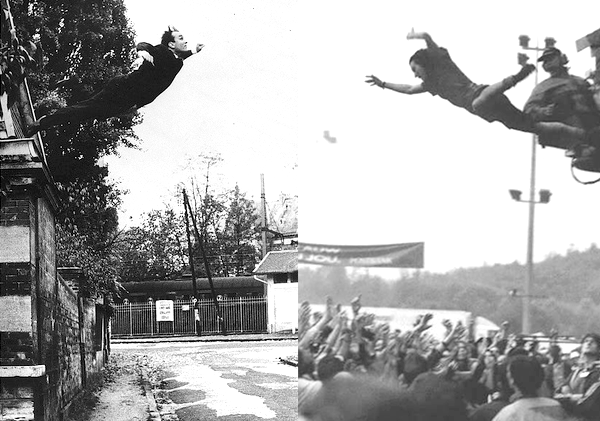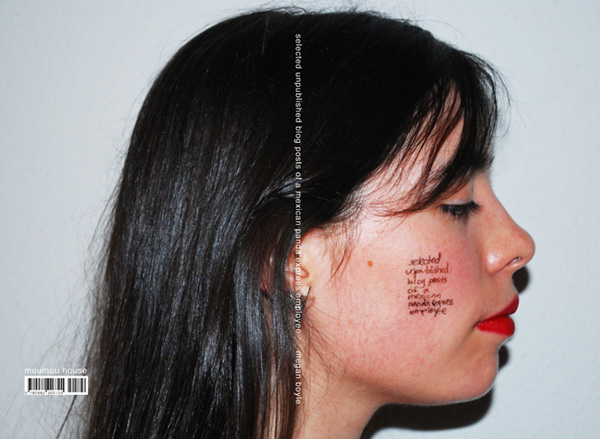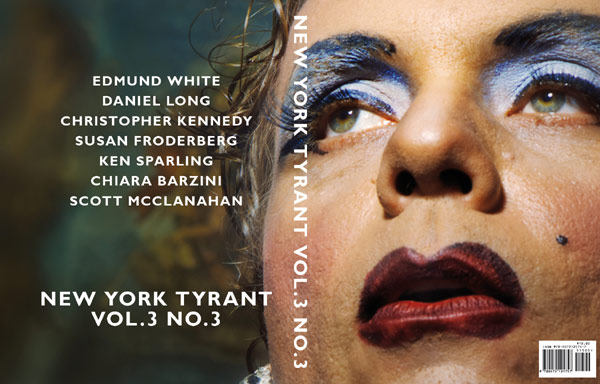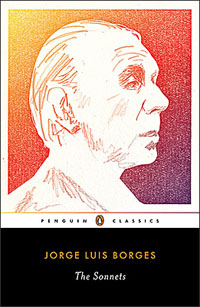A void

In 1960, Yves Klein set a tarpaulin on the street, leapt off a building onto it, later altered the photograph to make it all seem cooler, and called it “Le Saut dans le Vide (Leap into the Void).” No one expects the artist to have hurt himself in the making of said image, so we’ll give him the haha-ok nod. Of his other works, my favorite, is “Le Vide (The Void)” (1958) in which he showed an empty display case in an empty gallery in order to present nothing; of course, somewhat unfortunately, the presence of the display case in itself was necessary in invoking the theoretical absence of what might have been there. On the opening night, 3000 classy Parisians waited in line outside waiting to be let into the empty room. Some 30 years later, a then-disgruntled singer of a rather popular grunge band leapt off a stage set into his fans, lending an Olympic component to the “stage dive.” The fans braced the imminent collision with extended hands, together in a mutual crowd wave which I’ve always found endearing. To carry your fallen hero back to the alter is well worth the ticket, and chance of a sprained wrist. If the acceleration of gravity is godless physics, then the assumption that your fans will catch you is faith in one’s art. For your own personal Klein painting, this contributor encourages you to google map any of our vast oceans (zoomed in, satellite view); or, in his avoidance of work, this.
I’m sure I’ll regret asking, but I’m curious as to what people think/thought of the idea of the Occupy Wall Street Library?
Megan Boyle’s Selected Unpublished Blog Posts of a Mexican Panda Express Employee out today

Officially released today from Muumuu House, $12.
Beautiful logics, awkward brains, fun sentences, fresh new shitt!
TYRANT 9 PRE-ORDER/POST-OP

A year’s passed since the last issue of the Tyrant came out. That’s fucked up. This is unacceptable for a magazine that is supposed to be a bi-, or even tri-, quarterly, and my sole excuse is that I don’t have an excuse. I want to blame it all on Luke (co-editor, friend, part-time lover) in full, for moving to Texas, but I won’t, because I really can’t. Whatever took it so long (and come on, who noticed or really cares that much?), to try to make up for the time you’ve had to wait, I thought I would expose/humiliate/shame myself for you all to have a good cringe or laugh at. Hopefully maybe both. My idea for the cover was to have me in drag on it because I thought it would be really like, self-absorbed-seeming. I wanted to try to get ultra-vanity press on it, even though that doesn’t even mean that.
I’ve always thought drag queens were exceptionally brave people, but personally, I’ve never been “into” wearing women’s clothes or looking like a woman. However, I have done it twice in the past year so who knows what’s up with that. Drag is such an odd experience. For me, it was strangely intoxicating. While I was dressed up, and even for a couple of hours after, I felt like I’d been drugged, but in a good way. Probably best we don’t get into all that here though. READ MORE >
Sonnets From a Vague Suburb
 The Sonnets
The Sonnets
by Jorge Luis Borges
edited by Stephen Kessler
Penguin Books, 2010
336 pages / $18 Buy from Penguin Books, Buy from Amazon
Although justly famous in this country for his short fiction, Borges the poet remains largely unknown to American readers. This dual-language collection of his sonnets can go a long way towards remedying that deficiency. From his early atmospheric verse in Fervor de Buenos Aires, to his late poems of aging, nostalgia and death, written in the penumbra of near total blindness, Borges left behind a remarkable body of poetic work. We are still waiting for the complete works of Borges to be translated into English, but meanwhile, translator and editor, Stephen Kessler, has collected all of Borges’ sonnets into a single volume. Most of these were written when Borges was on his way to total blindness. The sonnet as a form called out to him in its succinctness and melody. Like oral poets of old, he found formal devices aided his memory, and so he composed sonnets in his head. The content of the poems is eminently recognizable to readers of his prose: the evocativeness of run-down suburbs, dusk, the gaucho, the warrior, the labyrinths of reason, the mysteries of time, identity, and mirrors.
November 14th, 2011 / 12:00 pm
The Sakura Review is looking for work. It’s a really beautifully made journal. Check it out.
THE TRANSPARENCY OF CAPITAL
(hat tip to “kashi butterfield”)
Sunday Service: Allyson Paty & Danniel Schoonebeek Poems
TORCH SONG: HOLY DAY
Our woman of black knees
in the dirt she is singing
sweetheart spit your teeth
into my hand and for you
I will play the finest rattle
•
The gossip about god was
he’s a woman drinks rotgut
no camisole sees the veins
in his husband’s eyelids says
hallelujah this is all my fault
TORCH SONG: SLUMGULLION
We come from low country we say
when thunderheads growl that’s god
talking to himself when lightning
strikes your mother down in a field
that’s god saying I’ve got a question
•
The furrow belongs to the crows now
no last stalk no cornhusk doll to march
through town and hang from the door
of the landlord who says shut her out
should the wheat ghost come to yours
TORCH SONG: CHANTEUSE
Hair teased out like a flame
an old standard (for the crowd)
got a feeling cause I’m blue oh
lord it disgusts me heartache
all this spectacle and prayer
•
There are nights I suspect
I will find you your fingers
sear at the tips a music box
in your hands your refrain
will no one turn this crank
Torch Songs is a collaboration between poets Allyson Paty and Danniel Schoonebeek. Colliding the form of the torch song in American music with the aubaudes of ancient Japanese female poets, each torch song is formed by joining together two five-line poems that the poets write in response to each other.
Allyson Paty is from New York. Her work has appeared or is forthcoming in Tin House, The Awl, DIAGRAM, Boxcar Review, and elsewhere.
Danniel Schoonebeek’s work has appeared or is forthcoming in Boston Review, The Rumpus, Tin House, Publishers Weekly, and elsewhere.
Five Albums For Saturday [2]
I did this sort of post last month. Thought I’d do it again.
It’s Saturday. I’m reading L=A=N=G=U=A=G=E magazine issue #6, which opens with a special section devoted to three chunks from Gertrude Stein’s Tender Buttons. Michael Davidson offers the first contribution in the issue, which he begins by making a distinction between the two ways that Stein scholars tended to categorize her work (granted this issue came out in 1978, but the categories still seem to be pretty paradigmatic examples of orthodox Stein interpretation): on the one hand, Davidson argues, her writing is seen as all play, deriving strictly out of her early research work with William James and automatic writing and later invigorated by Cubist formalism; on the other hand, her writing is seen as hermetically Symbolist, concerned with encoding sexual and biographical information in complex little verbal machines which contextualize their own environments. Both views, Davidson says, operate on either side of a referential paradigm: one wants her to mean nothing and the other wants her to mean intrinsically. But what makes Tender Buttons so vital, Davidson argues, is not the strategies by which meaning is avoided or encoded but how each piece points at possibilities for meaning.
I like this argument. It’s not about meaning vs. meaninglessness, it’s about exploring the possibilities engendered by the confounding nature of the text.
Anyway, here are five albums (plus two extra bonus albums!) I’ve recently been spinning, which I thought you might find interesting (hint: if you click on the artist and title it will take you to the magic place):

